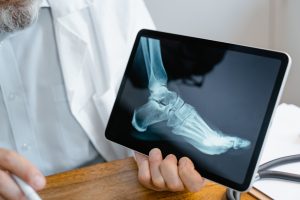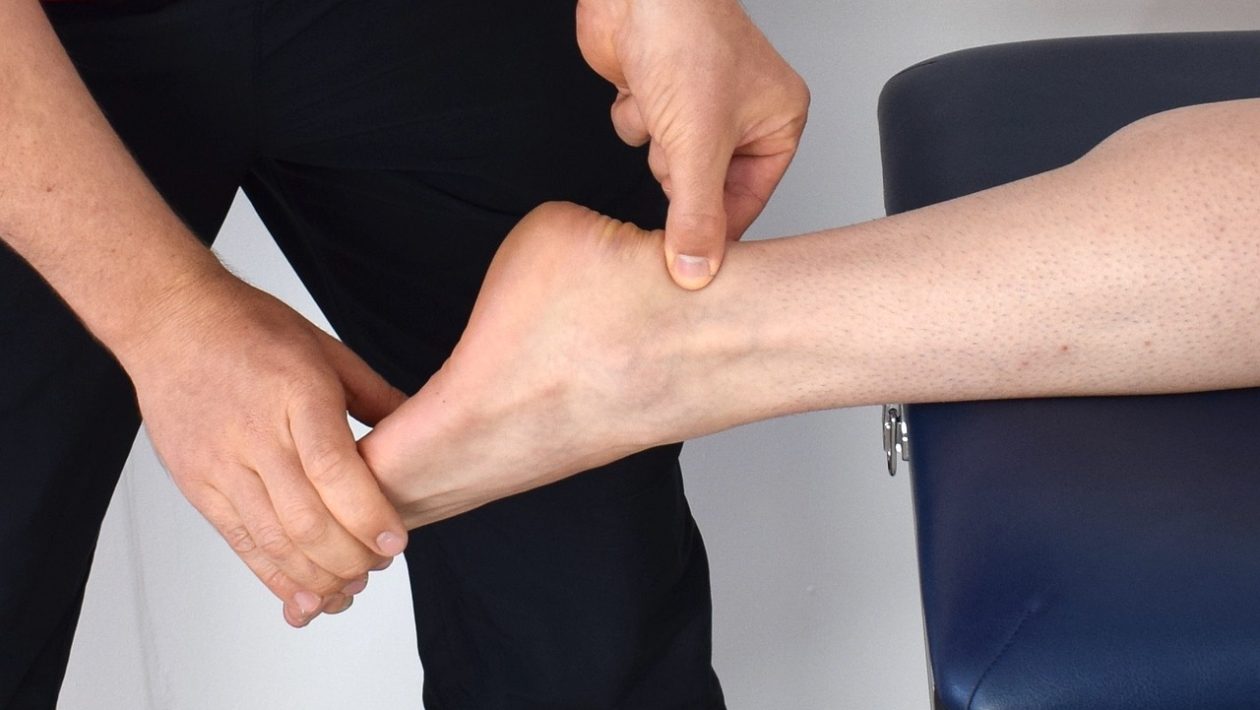A bone spur, also known as an osteophyte, is an out-of-proportion growth of bone that manifests itself for no discernible reason. Although bone spurs can form in any part of the body, the one that this article will discuss is the ankle. Bone spur in ankle is a painful condition that can impede a person’s ability to perform everyday activities.
Over time, these bone abnormalities can evolve into symptoms, including joint edema, inflammation, and even instability. Successful management of ankle bone spurs requires awareness of the condition’s manifestations and the pursuit of a correct diagnosis and therapy.
In this piece, we’ll look into the numerous treatment options for bone spurs in the ankle and examine the prevalent bone spur in ankle symptoms accompanying them. Ankle bone spurs can be treated in various ways, ranging from more conservative approaches like rest, physical therapy, and medicine to more extreme measures like injections or surgical treatments.
Table of Contents
Ankle Bone Spurs: What Causes Them?
A bone spur in ankle has several potential causes, the most common being repetitive stress and joint deterioration. Individuals can take preventative steps and make educated treatment decisions when they understand the reasons:
Osteoarthritis
In the instance of the ankle, cartilage deterioration results in osteoarthritis, a progressive joint ailment. It can cause harm and rubbing within the joint as the bones collide with one another.
Bone spurs are a natural joint defense that the body might develop in response to chronic stress. Although osteoarthritis of the ankle is often connected with aging, it can also occur due to past injuries.
Injuries To The Ankle
A bone spur in ankle can occur due to traumatic incidents, such as breaks, displacements, or even intense strains. When the ankle joint experiences injury, the body initiates the healing procedure, which can involve the generation of fresh bone. Bone spurs might develop from this new bone development over time.
A Tear In A Tendon Or Ligament
Bone spurs can occur through diseases that damage the tendons or ligaments in the ankle joint on a chronic basis. Tendonitis (a disorder characterized by inflammation of the tendons), ligament tears, or instability can disrupt ankle mechanics.
Bone spurs arise as the body tries to strengthen and consolidate weak tissues in response to abnormal stress and movement patterns.
Poor Foot Function
Extreme pressure on the ankle joint can occur through foot deformities like pes planus (flat feet) or pes cavus (high arches). The added stress may hasten joint degeneration and spur development.
Bone spur in ankle can also occur from biomechanical abnormalities like overpronation (extreme inward rolling of feet) or supination (extreme outward rolling of feet).

Propensity Determined By Genes
There may be a hereditary propensity for bone spurs in some people. Some people are genetically predisposed to developing bone spurs in the ankle due to inherited factors that affect bone and joint structure and composition.
Bone Spur In Ankle Symptoms: Learning To Recognize The Signs
Ankle bone spurs are a common cause of pain and other symptoms, the severity of which varies from person to person. One can achieve a correct diagnosis and prompt treatment if these symptoms are recognized.
Below are the most typical bone spur in ankle symptoms:
Ankle Pain That Won’t Go Away
Ankle discomfort that won’t go away is a common symptom of a bone spur. Pain might be minor to severe and limited to the affected area. One may experience aching, throbbing, or acute pain. Excessive movement, standing, or walking for extended periods may increase it. The discomfort may worsen first thing in the morning or after a long nap.
Inflammation And Puffiness
When a bone spur forms on the ankle, it can cause the tissues around it to enlarge and become inflamed. Swelling and tenderness to the touch are standard bone spur in ankle symptoms. Ankle bone spurs can cause pain and mobility issues due to inflammation, which is the body’s normal response to injury or irritation.

Motion Restriction
When the bone spur presses against the ankle joint, it might limit motion. Stiffness and decreased flexibility in the ankle joint can make even simple tasks like walking, running, and stair climbing difficult for those affected. A restriction in range of motion can severely impair a person’s mobility and quality of life.
Disrupted Joints
Ankle instability or weakness may result from bone spurs that weaken the joint’s stability. The uneven development can cause the ankle bones to shift out of position, rendering them more vulnerable to sprains and other problems. Feelings of instability or weakness in the ankle’s ability to bear weight are common.
A Clicking Or Grinding Sound
The crepitus is the grinding or clicking sound one can feel when a bone spur scrapes against other bones or tissues in the ankle joint. While moving the ankle, you may hear or feel this sensation. The annoying and unsettling sound of crepitus often accompanies the presence of a bone spur.
The degree and combination of the bone spur in ankle symptoms can differ from one person to the next. People can experience any range of the symptoms listed earlier or none at all. The intensity of symptoms also differs depending on the dimensions, position, and quantity of bone growth a person has.
Proper Diagnosis: How To Tell If You Have An Ankle Bone Spur?
Constant pain in the ankle, or other signs of a bone spur, necessitates a medical evaluation. Doctors can confirm the presence of a bone spur and determine the best course of treatment with an accurate diagnosis.
Here are the numerous techniques doctors use to identify a bone spur in ankle:
Physical Examination
An orthopedic expert or other trained medical professional must perform a thorough physical examination to rule out other possible causes of an ankle bone spur. The doctor will check the ankle for swelling, soreness, redness, or restricted movement. In addition, they will look into the patient’s medical history, specifically asking about any previous ankle injuries.
Diagnostic Imaging
Bone spur in ankle can only be properly diagnosed with the help of imaging studies. They offer comprehensive images of the region, allowing doctors to identify the location and size of the bone spur precisely. X-ray is the most popular imaging technique.
X-Ray
X-rays employ electromagnetic radiation to create images of bones, and they are a straightforward and painless diagnostic tool. Bone spurs, or abnormal growths around the ankle joint, can be easily identified with their help.
X-rays are also helpful in determining how severely the bone spur has damaged the joint. X-ray scans let doctors evaluate the severity of a patient’s disease and select the most effective treatment.
In rare circumstances, a more thorough look at the ankle joint and its environs may necessitate the ordering of further imaging studies.

Magnetic Resonance Imaging (MRI):
MRI scans show muscle, tendon, ligament, and cartilage clearly because of a strong magnetic field and radio waves. It gives a fuller picture of the ankle joint, so doctors may evaluate the degree of the bone spur’s damage and locate any other abnormalities or disorders. MRI is beneficial when further assessment is needed or when conservative treatments have failed.
CT Scan, Or Computed Tomography
A CT scan is essentially a sequence of X-rays collected at various angles. These help in making cross-sectional pictures of the ankle joint. CT scans help diagnose complex bone spur in ankle and measure the level of bone erosion produced by the spur because of the information they provide about the bone structure.
After completing the diagnostic imaging, the doctor will carefully review the data regarding the patient’s symptoms and the physical exam findings.
Clinical Assessment And Differential Diagnosis
Healthcare providers do a clinical examination to determine how the bone spur affects the patient’s quality of life and ability to complete daily tasks during diagnosis. One should evaluate the patient’s pain levels, mobility, and other restrictions.
The doctor may also think about alternate diagnoses to rule out illnesses similar to a bone spur in ankle. Ankle arthritis, tendinitis, ligament sprains, and stress fractures are among disorders that may present similarly.
Doctors can distinguish bone spurs from other potential causes by thoroughly evaluating and comparing symptoms, physical examination findings, and imaging data.
Ankle Bone Spurs: Possible Treatments
Ankle bone spurs are a common source of pain and immobility. The good news is that a wide range of bone spur in ankle treatment is available to help reduce symptoms and restore normal ankle function.
Standard methods for dealing with an ankle bone spur include the following:
Moderate Therapies
Ankle bone spurs are often treated initially with non-invasive, conservative methods. The goal is to achieve less discomfort and swelling in the ankle and better function without surgery. Examples of such therapies could be:
Adjusting Rest And Activity Levels
Resting the injured ankle and avoiding activities that worsen the pain and swelling can be helpful.
Rehabilitative Exercise
A physical therapist can create a unique training plan to restore standard movement patterns, increase muscle strength surrounding the ankle joint, and decrease pain. Stretching, resistance training, and flexibility exercises are all possible elements of physical therapy.
Medication
To relieve the pain and swelling caused by the bone spur in ankle, physicians may prescribe nonsteroidal anti-inflammatory drugs (NSAIDs) like naproxen or ibuprofen.
Orthotics
You can achieve support, proper alignment, and pain alleviation with the help of custom shoe inserts or orthotic devices. They can make carrying heavy objects more accessible and reduce discomfort.
Shoe Alterations
One can control bone spur in ankle with the help of supportive and cushioned shoes. Shoes with a roomy toe box can ease pain by preventing the toes from being squeezed together.
Injections
Ankle bone spurs can cause pain and swelling, both of which are treatable with injections. Injections like these are very common:
Corticosteroid Injections
The joint in the ankle is immediately injected with a potent anti-inflammatory drug. Reduced inflammation and temporary pain reduction are two of their main benefits.
Platelet-Rich Plasma (PRP) Injections
Plasma rich in platelets and growth factors (PRP) therapy uses the patient’s blood. The concentrated solution is injected into the ankle joint to speed recovery, lessen discomfort, and enhance tissue regeneration.
Hyaluronic Acid Injections
The joints of the human body inherently possess hyaluronic acid. Hyaluronic acid injections help lubricate the ankle joint and relieve associated discomfort.
Surgical Procedures
Surgery may be necessary if non-invasive treatments don’t help or the bone spur significantly damages or deforms the joint. The bone spur’s condition and severity will determine the surgery required. Possible surgical procedures are:
Arthroscopic Surgery
Small incisions and a miniature arthroscope camera are used in arthroscopic surgery, making it a minimally invasive bone spur in ankle treatment. Doctors can remove the bone spur with the help of endoscopic equipment. It allows the surgeon to see what’s happening inside the ankle joint. There will be less pain and scars from this operation than from others.
Osteotomy
If the bone spur has caused the ankle joint to become misaligned, an osteotomy may be necessary to correct the problem. The surgeon will cut and reshape the bones to restore alignment and alleviate pressure on the joint.
Fusion And Replacement Of Joints
If the joint damage caused by the bone spur in ankle is severe enough, a joint fusion or joint replacement may be necessary. By permanently connecting the bones, joint fusion eliminates motion and pain. In joint replacement surgery, the patient surgically removes the damaged joint surfaces and replaces them with an artificial joint implant.
Final Thoughts
Bone spur in ankle can seriously hinder a person’s ability to go about their routine. One can achieve an adequate diagnosis and therapy if the symptoms are recognized and medical attention is sought promptly. Ankle bone spur sufferers can find pain relief, enhanced mobility, and a return to their busy lifestyles with a combination of conservative therapies like rest, physical therapy, and medicine and more advanced interventions like injections or surgery. The intensity of symptoms and personal circumstances will define the best course of therapy; thus, it is essential to see a healthcare practitioner.

